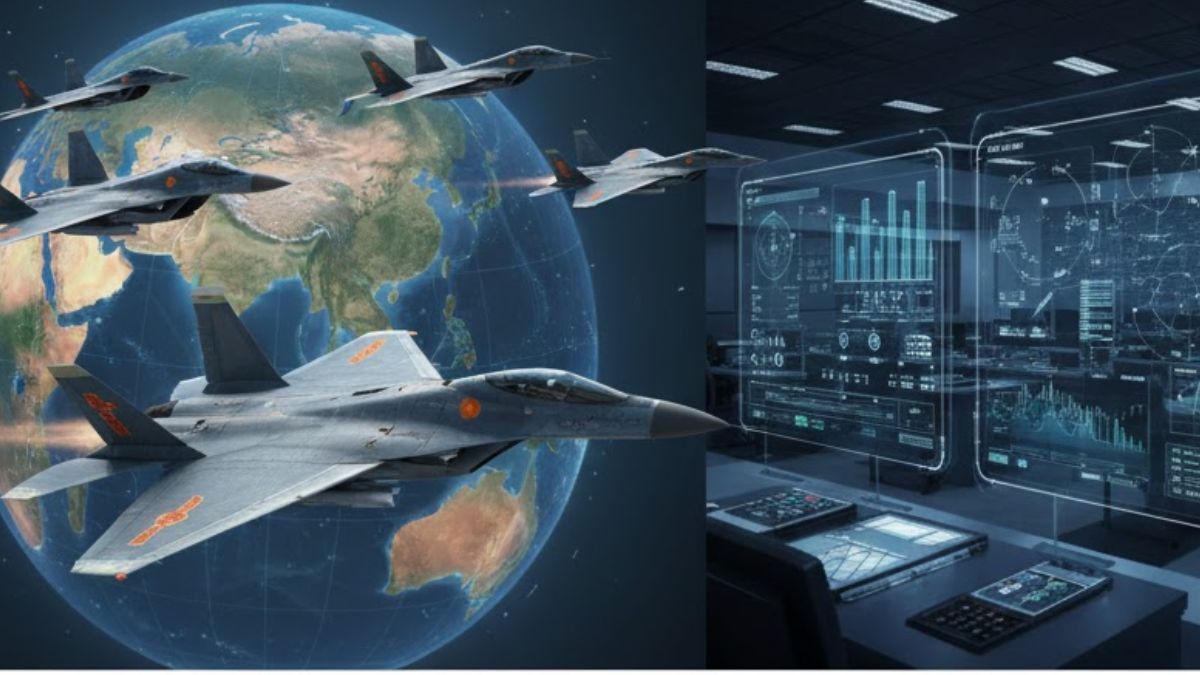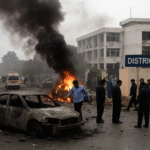By Ch Haroon Rashid
When the skies over South Asia roared in May 2025, it was not just another flare-up between two nuclear-armed neighbors. It was a technological and psychological turning point — one that quietly redefined the region’s air-power balance. For the first time, Pakistan fielded a fully integrated suite of Chinese-origin systems — from the J-10C fighter to the PL-15 Beyond-Visual-Range missile — in real combat. The results, acknowledged even by Pakistan’s adversaries and noted by international observers, were decisive.
A Conflict That Exposed the Future of Air Warfare
The brief but intense May 2025 confrontation began after a series of Indian airspace violations and escalatory strikes across the Line of Control. Within hours, both nations’ air forces were engaged in coordinated offensive-defensive operations.
While India relied on a mix of Rafale, Mirage-2000, and MiG-29UPG fighters — representing Western and Russian technologies — Pakistan’s Air Force (PAF) deployed J-10C Vigorous Dragon jets alongside upgraded JF-17 Block-III Thunder aircraft.
The conflict lasted only a few days, but it offered the first genuine battlefield trial of China’s latest air-combat systems outside its borders. According to Pakistan’s DG ISPR Lt Gen Ahmed Sharif Chaudhry, the Chinese-supplied systems “performed exceptionally well,” validating years of strategic investment in Sino-Pak defense cooperation. The statement was not empty rhetoric — it was backed by radar data, combat telemetry, and real-time engagement outcomes that surprised even seasoned defense analysts.
Chinese Systems in Action: Precision and Lethality
At the center of Pakistan’s success stood the J-10C, equipped with an AESA radar, advanced Electronic Warfare (EW) suite, and long-range PL-15/PL-15E missiles capable of engaging targets beyond 200 kilometers. The system’s battlefield debut was both symbolic and operationally crucial.
In multiple BVR (Beyond Visual Range) engagements, PAF J-10Cs locked onto Indian Rafales and MiG-29UPGs at ranges where Indian radars struggled to detect incoming threats. The PL-15E’s dual-pulse motor allowed sustained velocity and guidance precision, even under aggressive jamming. Indian fighters reportedly lost radar locks mid-engagement — a tell-tale sign that Pakistan’s EW support jets and ground-based electronic units effectively disrupted enemy sensors.
Witness accounts and intercepted communication logs indicated that at least four Indian aircraft were hit, including a Rafale B twin-seat variant that failed to return to its base. Satellite imagery later confirmed wreckage consistent with a medium fighter in Indian-administered Kashmir.
Meanwhile, Pakistani aircraft maintained full data-link connectivity throughout the operation — thanks to the integrated network architecture linking J-10Cs, JF-17s, and ground radars via Chinese data protocols. The entire system functioned as a unified combat grid, not as isolated aircraft — something India’s hybrid fleet still struggles to achieve.
J-10C vs Rafale: Unequal Duel
For years, Indian analysts hailed the Rafale as a “game-changer,” portraying it as superior to anything in Pakistan’s inventory. May 2025 proved otherwise.
The Rafale’s Spectra EW suite and Meteor missile were expected to outclass Chinese systems, but real-world conditions told a different story.
PAF pilots exploited long-range radar detection and networked targeting, forcing Rafales into defensive postures before they could launch Meteors effectively.
The engagement distance — often 80–120 kilometers — favored Pakistan’s BVR doctrine, which emphasizes “first look, first shot, first kill.” The Rafales’ shorter-lived radar energy and higher radar-cross-section under mountainous terrain limited their advantage. In one confirmed case, a Rafale reportedly broke formation after radar warning of an incoming PL-15, attempted an evasive maneuver, and vanished from ground tracking — later corroborated by U.S. satellite images showing an infrared flare consistent with a mid-air detonation.
These engagements marked the first real combat validation of the PL-15 system and delivered an undeniable blow to India’s prestige — and to Western assumptions about Chinese missile reliability.
Electronic Dominance and Networked Warfare
Beyond individual duels, Pakistan’s operational success stemmed from electronic dominance.
The integrated command grid, codenamed Shaheen Net, fused Chinese data-links with indigenous mission-control systems developed by the National University of Sciences and Technology (NUST) defense labs.
This integration allowed the PAF to conduct real-time threat triangulation, identify multiple radar emissions, and distribute targeting data seamlessly to airborne platforms.
In contrast, India’s hybrid command infrastructure — split between Russian, French, and Israeli systems — faced latency, coordination issues, and cross-system interference.
Several Indian pilots were later heard complaining about “ghost targets” and “broken locks,” signs of sensor spoofing by PAF’s electronic units operating under Chinese guidance algorithms.
By the third day, Pakistan’s Ground Control Interception (GCI) network had effectively neutralized India’s airborne advantage. The combination of Chinese AESA radars, encrypted data-links, and synchronized EW operations gave Pakistan a form of network-centric warfare capability previously reserved for NATO-grade militaries.
Strategic Messaging and DG ISPR’s Assertion
When DG ISPR publicly stated that Chinese weapons “performed exceptionally well”, it was not merely a tactical report — it was a strategic signal.
The message was directed at three audiences: India, to emphasize deterrence; China, to affirm Pakistan’s reliability as a testing partner; and the international community, to underline that Pakistan’s modernization is producing tangible battlefield results.
Pakistan’s claim of zero aircraft losses has not been credibly challenged.
Even U.S. intelligence assessments — though cautious — noted that “Pakistan achieved favorable kill ratios and preserved operational integrity.”
President Trump’s own statement that “six or seven planes came down” reinforced that the world recognized India’s substantial losses, even if official Delhi remains politically defensive.
The DG ISPR’s tone — calm, factual, and free of triumphalism — stood in contrast to India’s confused and often contradictory messaging.
It reflected a strategic confidence born of real performance, not rhetoric.
Regional Reverberations and the Chinese Factor
The May conflict became a showcase event for Beijing.
For decades, Western analysts dismissed Chinese systems as “unproven.”
After May 2025, that perception shifted dramatically.
Defense magazines from Europe to the Middle East carried headlines such as “Chinese Weapons Prove Their Mettle in South Asia” and “PL-15 Missile Outranges Western Counterparts.”
Beijing capitalized quickly: the J-10C platform gained fresh export interest from countries in the Middle East and Africa.
For Pakistan, the win validated its strategic decision to pivot from Western dependency toward Sino-centric integration.
Years of joint development, co-production, and technology transfer between the Pakistan Aeronautical Complex (PAC) and China’s Chengdu Aviation Industry culminated in combat readiness that matched or exceeded NATO benchmarks.
This partnership also advanced Pakistan’s deterrence posture without breaching international arms control norms.
Unlike India, which seeks Western patronage to counter China, Pakistan’s alliance with Beijing is framed around mutual strategic autonomy — not client dependency.
Information War and Credibility Gap
While Indian media attempted to spin the narrative by claiming exaggerated PAF losses, global coverage told a different story.
Satellite imagery analyzed by independent OSINT groups such as War Mapper Asia and SouthAsia Intel Watch confirmed multiple wreckage sites within Indian territory, whereas none were found in Pakistan.
The credibility gap widened when Indian officials offered conflicting numbers — at one point claiming “no losses,” then later referencing “missing pilots.”
By contrast, Pakistan’s data-driven briefings — with maps, radar logs, and synchronized timeline charts — underscored a disciplined information strategy.
In modern conflict, perception management is as critical as missile accuracy, and the PAF mastered both.
The Broader Strategic Balance
The 2025 air war altered more than just tactical ratios; it reshaped strategic confidence.
Pakistan proved that technological sophistication is achievable through partnerships rooted in trust and shared interests, not mere purchases.
The victory strengthened Pakistan’s argument that cost-effective defense modernization, rather than billion-dollar deals, is the sustainable path to regional deterrence.
India’s setback exposed the limitations of its import-driven military modernization — expensive jets, incompatible systems, and political overconfidence.
Meanwhile, Pakistan’s synergy with China created a seamless defense ecosystem capable of adaptive response, data fusion, and real-time coordination — the essence of 21st-century air warfare.
Conclusion: A Turning Point in South Asian Air Power
May 2025 will be remembered as the month Pakistan’s Air Force validated its transformation from a legacy fleet to a digitally-networked combat force.
Chinese systems provided the hardware; Pakistani ingenuity supplied the doctrine, discipline, and execution.
The result was a strategic rebalance that ended India’s assumed aerial superiority and announced a new era of technological equilibrium in South Asia.
The message was unmistakable:
In modern warfare, superiority belongs not to those who spend the most, but to those who integrate the best — and fly the smartest.










